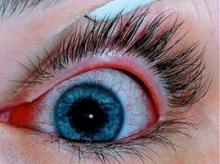When prescribing isotretinoin for acne, ocular lubricants should also be prescribed, according to Dr. Meira Neudorfer and colleagues.
The researchers, who conducted a large, retrospective study of young adults who received prescriptions for isotretinoin for acne, also recommended that "a follow-up visit to the ophthalmologist should be scheduled about 4 months after the first dispensed isotretinoin prescription."
The recommendations come from their study findings which compared 14,682 adolescents and young adults who were new users of isotretinoin, with two age- and sex-matched control groups. The first comparison group of 14,682 patients had acne, but the patients were never treated with isotretinoin; and the second comparison group of 14,682 patients did not have acne and were never treated with isotretinoin (Arch. Dermatol. 2012;148:803-8).
Isotretinoin use was associated with an increased risk for developing ocular disorders – an attribution established by previous studies – which are mostly reversible once the therapy is discontinued. The elevated risk of adverse events is attributed to the biological effect of isotretinoin, inducing meibomian gland dysfunction, wrote Dr. Neudorfer of the department of ophthalmology at Tel Aviv Medical Center, and colleagues.
Data were collected from the electronic database of the health maintenance organization, Maccabi Healthcare Services, Tel Aviv, between January 1, 2000, and December 31, 2007. The recommended dose of isotretinoin in Israel is a cumulative dose of 120-150 mg/kg.
During the first year of treatment, 13.8% of the isotretinoin group experienced adverse ocular events, compared with 9.6% of the isotretinoin-naïve patients, and 7.1% of the acne-free patients. The most common adverse events were conjunctivitis, hordeolum, chalazion, blepharitis, eye pain, and dry eye, according to the study.
Inflammatory ocular diseases were diagnosed in 6.7% of the isotretinoin group, 3% of the isotretinoin naive group, and 2.4% of the acne-free group. Structural ocular diseases were observed in 1.0%, 0.5% and 0.4% of the three groups, respectively.
Acute conjunctivitis was the most frequent prognosis and occurred 1.7 times more frequently in the isotretinoin group than in the isotretinoin-naive group (4.0% vs. 2.4%, respectively). In the acne-free group, the occurrence was 1.9%.
The study also found an increased incidence of ocular adverse events among female patients, which was "in line with the known greater use of health care services by women," the researchers noted.
The authors listed several limitations to the study. For instance, patients with acne experienced more ocular disease than did the general population because of the disease itself, so "it is reasonable to assume that the ocular disturbance is directly associated with the degree of acne severity," they wrote. There was also a lack of data on contact lens use, something that could lead to complications and influence the association between use of isotretinoin and ocular disease.
"The study results underscore the importance of primary and secondary prevention measures," the authors concluded. "When patients taking isotretinoin are seen with ocular problems, ophthalmologists should ascertain the timing of the onset of symptoms and consider discontinuation of the drug if the symptoms progress or persist despite treatment."
The authors did not report having any conflicts of interest.


